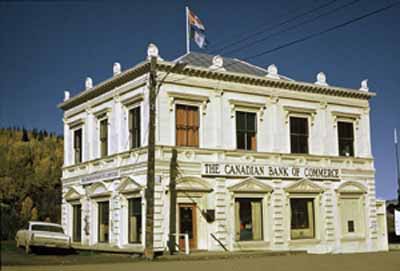Canadian Bank of Commerce National Historic Site of Canada
Dawson, Yukon Territory

General view
© Parks Canada Agency / Agence Parcs Canada, 1985.
Address :
Front Street, Dawson Historical Complex National Historic Site of Canada, Dawson, Yukon Territory
Recognition Statute:
Historic Sites and Monuments Act (R.S.C., 1985, c. H-4)
Designation Date:
1988-06-24
Dates:
-
1901 to 1901
(Construction)
-
1898 to 1989
(Significant)
Event, Person, Organization:
-
Klondike Gold Rush
(Event)
-
Robert Service
(Person)
-
W.P. Skillings
(Architect)
-
Robert Moncrief
(Builder)
Other Name(s):
-
Canadian Bank of Commerce
(Designation Name)
-
Bank of Commerce
(Other Name)
Research Report Number:
1967-16, 1988-A05
Plaque(s)
Existing plaque: On a rock by the Bank Building Front Street, Dawson, Yukon Territory
Klondike gold! Buying and melting it into bricks, brokering it on world markets, bankrolling entrepreneurs' huge inventories to last the northern winters - these and other important services were performed by the Canadian Bank of Commerce in Dawson, from the Gold Rush of '98 until 1989. Robert Service was among the clerks who worked here, before his poetry earned him financial independence and the honorary title "Bard of the Yukon." Built in 1901, this Renaissance Revival building is one of Canada's finest surviving structures clad in decorative pressed metal.
Description of Historic Place
The Canadian Bank of Commerce National Historic Site of Canada is located on the riverfront in Dawson City, Yukon. It is a handsomely designed, two-storey wood structure of native spruce with ornamental pressed metal fronts sanded and painted to resemble grey sandstone. Despite its small size and modest construction materials, the building is an ambitious essay in classical architecture, featuring a cornice, pilasters, elaborate mouldings and artificial rustication, all executed in pressed metal. Official recognition refers to the building on its legal lot at the time of designation.
Heritage Value
The Canadian Bank of Commerce was designated a national historic site of Canada in 1988 because: important services were performed by the bank, from the Gold Rush of ‘98 until 1989; this Renaissance Revival building is one of Canada’s finest surviving structures clad in decorative pressed metal.
The heritage value of Dawson City’s Canadian Bank of Commerce lies in its longstanding role in Yukon history, in the excellence and sophistication of its design and composition, particularly in a northern environment, and in its prominent location in the historic Gold Rush town of Dawson. Originally housed in a tent, the Canadian Bank of Commerce relocated several times before finally settling in the current building designed and built by W.P. Skillings and Robert Moncrief in 1901. Its grand architectural style reflects the important services that were performed by the bank, such as the buying and melting of gold into bricks and the brokering of gold on world markets. This structure, with its sophisticated form, was a prominent and visible symbol of the bank’s significance within the community. It operated as a bank until 1989.
Source: Historic Sites and Monuments Board of Canada, Minutes, November, 1991; Plaque text, 1991.
Character-Defining Elements
Character defining elements
Key elements contributing to the heritage value of this site include: its location in Dawson’s business section, relatively isolated from the predominantly wooden structures; its rugged, northern setting within the Dawson Historical Complex National Historic Site of Canada, as well as its spatial relationships with other buildings within the complex; its cubic two-storey massing under a very low hip roof; its Renaissance Revival design with a four-bay symmetrically organized façade, side entry, classically-inspired ornamentation including pilasters, dentilled cornice topped by finials, and alternating pedimented and arched window surrounds on the ground floor with bracketed mouldings above; its pressed metal facing worked to resemble stone, particularly in its imitation rustication, fluted pilasters, and decorated entablature topped with anthemion; its light-weight platform frame wood construction; its original interior plan and remaining original interior furnishings and finishes; viewscapes toward the building from Queen and Front streets and from the river.